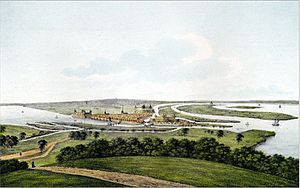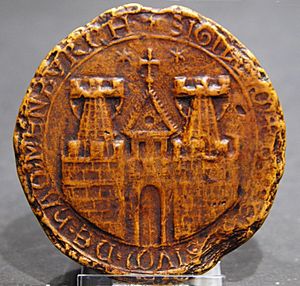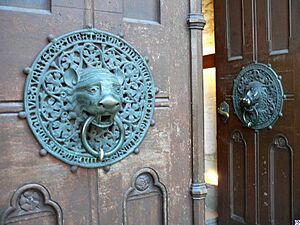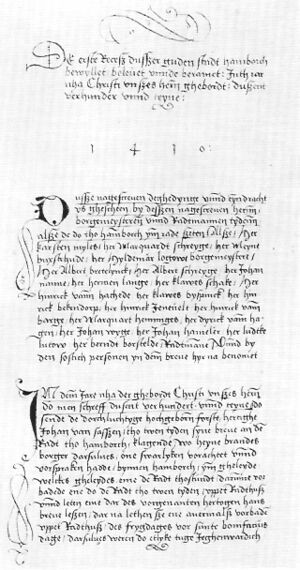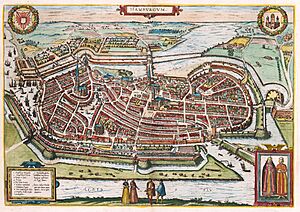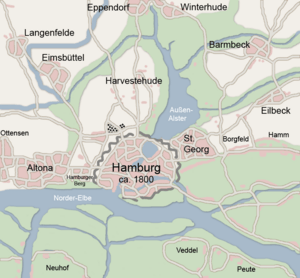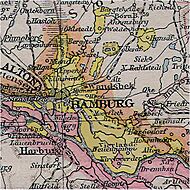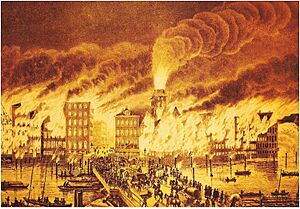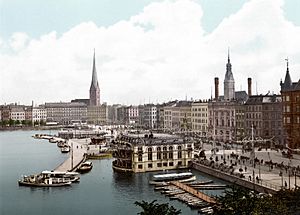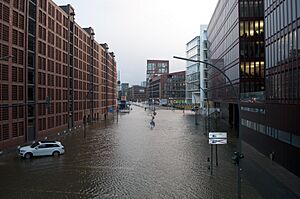History of Hamburg facts for kids
Hamburg was founded in the 9th century as a mission to convert the Saxons. For many centuries, it has been a very important trading center in Europe. Its great location by the port and its long history as an independent city and state made it very strong.
The city was a member of the powerful Hanseatic trading league in the Middle Ages. It was also a free imperial city within the Holy Roman Empire. From 1815 to 1866, Hamburg was an independent state in the German Confederation. Later, it joined the North German Confederation (1866–71) and the German Empire (1871–1918). During the Weimar Republic (1918–33), it remained a city-state. In Nazi Germany, Hamburg was a city-state and a Gau from 1934 to 1945. After Second World War, Hamburg was in the British Zone. It became a state in western Germany as part of the Federal Republic of Germany in 1949.
Contents
What's in a Name?
The first name for the settlement was Treva. A fortress built there was called Hammaburg. In an old German language, burg means "fortress". The meaning of Hamma is not fully known. It might refer to a bend in a river or a piece of land shaped like an angle. Another idea is that the castle was named after a large forest nearby called hammen. Some think Hamburg comes from an Old Saxon word, ham, which means a grassy river bank or a meadow by a river.
Early Days: From 808 AD to 1189 AD
The very first people in this area were hunters and gatherers. They lived here between 20,000 and 8000 BC. The first lasting settlements appeared around 4000 BC. This early group of hunters is known as the Hamburg culture.
In 808 AD, Emperor Charlemagne ordered a castle to be built. This was to defend against attacks from Slavic people and Vikings. Charlemagne's son, Louis, built this castle in 810. It was on an old trading path. On December 25, 831, Ansgar became the archbishop for the Hammaburg. Ansgar later became known as the "Apostle of the North."
In 845, Vikings sailed up the River Elbe. They destroyed Hamburg, which had about 500 people at that time. Two years later, Hamburg was joined with Bremen. Hamburg was destroyed again in 880 by Slavic and Danish soldiers. In 983, King Mstivoj of the Obodrites destroyed the town once more.
There were four famous castles linked to Hamburg in the 11th century. The bishop's castle, also called Bischofsturm, was built around 1037. The Wiedenburg was built in 1043. The Alsterburg never truly existed. The Neue Burg was built in 1023. After more raids in 1066, the bishop Adalbert moved to Bremen for good.
In 1188, Hamburg adopted the Lübeck law. This was a set of rules for the city.
Growing Strong: 1189–1529
In 1189, Frederick I, Holy Roman Emperor gave Hamburg special rights. These rights made Hamburg a free imperial city. This meant it was free from taxes and could use the Lower Elbe River to the North Sea without paying fees. It also got rights to fish, cut trees, and was free from military service. This was given because Hamburg supported Frederick's crusades.
In 1190, the old city and the new city formed a council. Valdemar II of Denmark attacked and took over Hamburg in 1201. In 1214, Frederick II, Holy Roman Emperor gave up all claims to land north of the Elbe River. Denmark then controlled Hamburg. The Danish governor united the old and new parts of Hamburg under one law. But a series of Danish defeats, ending with the Battle of Bornhöved in 1227, freed Hamburg. Hamburg then came under the rule of Adolf IV of Holstein. Starting in 1230, new defenses were built. You can still see their layout in names today, like Planten un Blomen park, which is built on the old fortifications.
On August 5, 1284, a huge fire destroyed almost all of Hamburg. In 1350, the Black Death, a terrible sickness, killed over 6,000 people in Hamburg. This was half of the city's population.
The Hanseatic League
Two agreements between Hamburg and Lübeck in 1241 started the powerful Hanseatic League. This was a group of trading cities. The first agreement said both cities would protect their freedom together. The second said they would keep the road between them safe from bandits. In 1264, the main trade route in Hamburg was paved with stones. This was one of the first paved roads in northern Europe.
In 1266, an agreement allowed Hamburg traders to set up a hanse (trading post) in London. This was the first time the word hanse was used for the Hanseatic League. In 1368, a fleet of 37 ships and 2,000 armed men, including ships from Hamburg, captured and destroyed Copenhagen. In 1377, a new money system, the Mark, was created by several cities, including Hamburg. Hamburg's most important export was beer. At this time, Hamburg had 14,000 people. It was the third-largest city in the Hanseatic League.
Pirates were a big problem. On October 21, 1401, the pirate Klaus Störtebeker was executed in Hamburg. In 1433, Simon van Utrecht defeated the pirates.
Hamburg's First Constitution
Hamburg got its first constitution on August 10, 1410. This happened after a disagreement between the citizens and the city leaders. A citizen named Hein Brandt had insulted a duke who owed him money. The duke complained, and Brandt was arrested. This made the citizens very angry. They formed a council because the city's leaders (the senate) were made up of the richest citizens and didn't have to explain their decisions.
The new Council of the Sixty demanded Brandt's release and talks. The mayor, Kersten Miles, and the senate freed Brandt. After four days of talks, they agreed to 20 important points. These points included:
- No citizen, rich or poor, could be arrested without a hearing.
- The senate could not start a war without asking the citizens.
- The senate could not protect someone who owed money to a Hamburg citizen.
- Disputes between the senate and citizens had to be fixed right away.
- Disloyal public servants had to be fired.
This agreement is seen as Hamburg's first constitution.
Changes with the Lutheran Church
On May 15, 1529, Hamburg became a Lutheran city. The city leaders asked Martin Luther to send his friend Johannes Bugenhagen to create a new church order. This created a state church for Hamburg. Services were held in Low German, and each church elected its own pastors. Old statues and altarpieces were saved and are now in museums.
At the same time, on February 24, a new agreement called the "Long Compromise" changed the political system. The senate, now with 24 members, handled the city's daily work and legal matters. But no new laws could be made without the citizens' council. These councils were elected by the city's four church areas, which also became administrative parts of the city.
In May 1531, the Catholic cathedral closed. It reopened as a Lutheran church in 1540. Roman Catholics lost their citizenship and were asked to leave the city. They could only practice their religion in small private chapels. It wasn't until 1785 that the city leaders officially recognized a small Catholic community.
In 1558, the Hamburg stock market was started. In 1567, Hamburg invited English traders to settle in the city. This went against the rules of the Hanseatic League. But Hamburg used the taxes from these traders to pay off its public debt. This debt came from Hamburg's help in the Schmalkaldic War (1546–1552).
Modern History
17th and 18th Centuries
To protect Hamburg from the Thirty Years War (1618–1648), new city defenses were built. A "New Town" (Neustadt) was also created. Many street names today still come from the way these new roads were planned.
In the late 1580s, the first Sephardi Jews arrived in Hamburg. They were escaping from Portugal. They formed a Jewish community. By 1610, there were about 100 Jewish families. Some Lutheran religious leaders spoke against them. In 1611, the city leaders had to ask universities for their opinions. The universities said that Jews should be allowed to live in the town as strangers. They were granted safety, but attacks against individual Jews still happened. They were not allowed to practice their religion openly, but small private prayer rooms were allowed. The first small synagogue was built in 1660.
In 1664, the city leaders passed a law to protect the city's swans. There were harsh punishments for harming a swan. A popular belief says that Hamburg will stay free as long as swans live on the Alster river.
In 1712 and 1713, a terrible sickness called the plague spread in Hamburg. In 1762, Danish forces briefly took over the city. They wanted to raise money for a war with Russia.
The 19th Century
Hamburg was briefly taken over by Napoleon I from 1810 to 1814. It became the capital of a French department. Hamburg suffered a lot during this time. But it raised two groups of fighters, the Hamburg Citizen Militia and Hanseatic Legion, to fight against Napoleon. Allied forces surrounded the city for over a year. Russian forces finally freed the city in 1814. This war helped create a strong sense of community spirit in Hamburg.
Hamburg was part of the 39-state German Confederation from 1814 to 1866. It was a fully independent state. After some political unrest, especially in 1848, Hamburg adopted a democratic constitution in 1860. This allowed adult male taxpayers to elect the Senate, which was the city-state's governing body. New ideas included separating powers, separating church and state, and freedom of the press and assembly. Hamburg joined the North German Confederation (1866–71) and the German Empire (1871–1918). In 1888, it was one of the last states to join the German Customs Union. It kept its self-governing status during the Weimar Republic (1919–33).
During the first half of the 19th century, a goddess named Hammonia became a symbol for Hamburg. She represented the city's spirit.
In 1842, about one-third of the city was destroyed in the "Great Fire." This fire lasted from May 4 to May 8. It destroyed three churches, the town hall, and many other buildings. It killed 51 people and left about 20,000 people without homes. Rebuilding took more than 40 years. As part of this rebuilding, Hamburg built Europe's first large, modern sewage system.
Hamburg grew very quickly in the second half of the 19th century. Its population more than quadrupled to 800,000 people. The city's trade with the Atlantic helped make it Europe's third-largest port. Building the port caused some of Hamburg's smaller rivers and channels to disappear.
In 1892, a major outbreak of cholera happened. The city government handled it very poorly. About 8,600 people died in this epidemic. It was the largest German epidemic of the late 19th century. Hamburg's water supply from the Elbe River was not clean. The authorities kept denying there was an epidemic. The German government used this scandal to reduce the city authorities' power.
The 20th Century
With Albert Ballin as its leader, the Hamburg-America Line became the world's largest shipping company around 1900. Hamburg also had shipping companies going to South America, Africa, India, and East Asia. Hamburg became a global city based on worldwide trade. It was the port where most Germans and Eastern Europeans left for the New World. It also became home to trading communities from all over the world.
German Revolution
After the November Revolution, workers' and soldiers' councils took control of the city. They agreed to hold free elections on March 16, 1919. There were six elections from 1919 to 1933. In the first election, the SPD and DDP parties formed a group. However, after World War I and the Great Depression, people started to support more extreme ideas. In the last election, the Nazi Party got 35% of the votes. This led to the Nazi rule that followed.
Nazi Germany
After the Nazis took power in Germany, they wanted to control all parts of the country. On March 3, 1933, the Nazi Interior Minister demanded that Hamburg's leaders stop the Social Democratic newspaper. When they agreed, three Social Democratic members of the city's government resigned. The next day, the President of the Senate also resigned. The Nazis then demanded that a Nazi Party member lead the police. When this was refused, Nazi stormtroopers caused public disturbances. The Nazi minister used this chaos to put an SA officer in charge of the police.
On March 8, 1933, the city parliament elected Carl Vincent Krogmann as mayor. He formed a government mostly made up of Nazis. On April 7, a new law gave the central government more control over the states. Karl Kaufmann, the Nazi Party leader for Hamburg, was put in this new powerful position on May 16. On January 30, 1934, the city parliament was removed, and all the state's powers went to the central government. Hamburg became just an administrative unit of the German government. Kaufmann gained more power over the city-state.
On April 1, 1937, the "Greater Hamburg Act" greatly expanded the city's borders. It included nearby cities like Altona, Harburg-Wilhelmsburg, and Wandsbek, plus many smaller towns. In return, Hamburg gave up a few small areas, like Cuxhaven. Hamburg was renamed Hansestadt Hamburg (Hanseatic City of Hamburg). The way Hamburg was governed was changed again in 1938. Kaufmann remained in charge of the state government. The Hamburg Senate and the position of Governing Mayor were removed. Krogmann's title was changed to just Mayor, and he only managed city services.
During World War II, Hamburg suffered many terrible air raids. These bombings killed 42,000 German civilians. British bombers dropped 23,000 tons of bombs, and Americans dropped 16,000 tons. As the bombings continued, more and more people moved out. By May 1945, half a million people (35%) had left.
Because of the bombings, much of the inner city's old buildings were destroyed. From 1938 to 1945, a concentration camp called Neuengamme concentration camp was in Hamburg. Some of its buildings are still there and serve as a memorial. From 1939 to 1945, over 500,000 people, including prisoners of war, were forced to work for more than 900 companies in Hamburg. They lived in over 1,200 camps across the city.
After World War II
After World War II, Hamburg was part of the British-occupied zone from 1945 to 1949. British officials worked to rebuild the city and bring back local leaders. Important trials for war crimes were held in Hamburg. Radio Hamburg, a public radio station, started broadcasting on May 4, 1945, even before the war officially ended.
The Iron Curtain was only about 50 kilometers (31 miles) east of Hamburg. This separated the city from much of its trading area and reduced Hamburg's global trade. On February 16, 1962, a severe storm caused the Elbe River to flood. It covered one-fifth of Hamburg and killed over 300 people.
Since the 2000s
After German reunification in 1990, and when some Eastern European countries joined the EU in 2004, Hamburg aimed to regain its position. It wanted to be the region's largest deep-sea port for container shipping and a major trading center.
In 2008, work began to change an old part of the Port of Hamburg called Grasbrook. This area is being turned into a new neighborhood called HafenCity. This project includes modern offices, homes, parks, and the famous Elbphilharmonie concert hall. The Elbphilharmonie was designed by Swiss architects and opened in January 2017.
In 2015, a part of HafenCity called Speicherstadt was named a UNESCO World Heritage Site. This area is known for its old warehouse buildings.
On July 7 and 8, 2017, the G20 summit took place in Hamburg. There were protests and riots during this event.
See also
 In Spanish: Historia de Hamburgo para niños
In Spanish: Historia de Hamburgo para niños
- Postage stamps and postal history of Hamburg
- Timeline of Hamburg history


